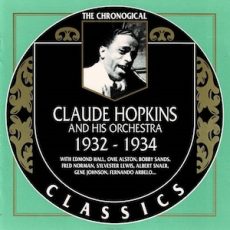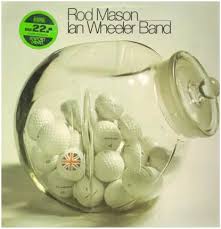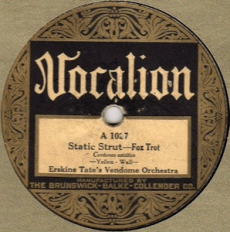
Daily Dose Of Jazz…
Sylvester Lewis was born on October 19, 1908 in Kansas City, Missouri and played locally as a college student around the city in the 1920s. His first major tour was with a traveling revue called Shake Your Feet, where he met Herbie Cowens. This meeting led to him joining the Cowens group, playing at the Rockland Palace in New York City in 1928.
He recorded with Jelly Roll Morton in New York the same year. After a stint with Aubrey Neal in 1929, Lewis joined Claude Hopkins’s band, playing with him from 1930 to 1936 and recording with him extensively between 1932 and 1935.
Leaving Hopkins, he performed in Billy Butler’s orchestra for the theater show Rhapsody in Black and played in Noble Sissle and Eubie Blake’s Shuffle Along in 1941. Sylvester led his own band for troop tours of the Pacific during World War II, and recorded with Roy Eldridge in 1946 after his discharge.
He began studying the Schillinger system in the late 1940s, but gave up music entirely after 1949 and spent the rest of his life working for the New York City Subway.
Trumpeter Sylvester Lewis died in 1974 in New York City.
More Posts: history,instrumental,jazz,music,trumpet

Daily Dose Of Jazz…
Clarence Williams was born on October 8, 1898 in Plaquemine, Louisiana to Dennis, a bassist, and Sally Williams. He ran away from home at age 12 to join Billy Kersands’ Traveling Minstrel Show, then moved to New Orleans, Louisiana. He first worked shining shoes and doing odd jobs, but soon became known as a singer and master of ceremonies.
By the early 1910s, he was a well-regarded local entertainer also playing piano, and was composing new tunes by 1913. Williams was a good businessman, working arranging and managing entertainment at the local Black vaudeville theater. He played at various saloons and dance halls around Rampart Street, and in the clubs and houses in Storyville.
He started a music publishing business with violinist/bandleader Armand J. Piron in 1915, which by the Twenties was the leading Black owned music publisher in the country. He toured briefly with W. C. Handy, and set up a publishing office in Chicago, Illinois before settling in New York City in the early 1920s. During the decade he and his blues singer/actress wife Eva Taylor moved to the borough of Queens with the intention of creating a community of black artists.
He was one of the primary pianists on scores of blues records recorded in New York during the 1920s. He supervised the 8000 race series recordings for the New York offices of Okeh phonograph company in the 1920s. He also recorded extensively, leading studio bands for OKeh, Columbia, Vocalion, Bluebird and occasionally other record labels.
As a producer he participated in early recordings by Louis Armstrong, Sidney Bechet, Bessie Smith, Virginia Liston, Irene Scruggs, his niece Katherine Henderson, and others. Most of his recordings were songs from his publishing house.
In 1943, he sold his extensive back-catalogue of tunes to Decca Records for $50,000 and retired. He bought a bargain used-goods store, the Harlem Thrift Shop.
Pianist, composer, promoter, vocalist, theatrical producer, and publisher Clarence Williams, died on November 6, 1965 in Queens, New York.
More Posts: bandleader,composer,history,instrumental,jazz,music,piano,producer,promoter,publisher,vocal

Daily Dose Of Jazz…
Dieter Antritter was born in Pforzheim, Germany on October 6, 1929. After the end of World War II he started first to learn guitar, then later he switched to soprano saxophone. A move to Stuttgart, Germany gave him the opportunity to connect with the local jazz-scene.
On holiday in Paris, France in 1949, he unsuccessfully attempted to meet Sidney Bechet. However, Dieter eventually met Charles Delaunay, who opened him to the possibility of jamming with contemporary jazz greats living in Paris that time. Improving his playing, he built up a network with a few well-known jazz musicians.
Returning to Stuttgart in 1952 he founded the Latin Jazz Band. He used his concerts as a platform for guest musicians from his Paris connection to perform. From this band the Quartier Latin Jazz Band emerged, which existed until at least 2009. During those years this band accompanied numerous guest soloists such as Michel Attenoux, Peanuts Holland, Mezz Mezzrow, Benny Waters and Nelson “Cadillac” Williams.
In 1960, this led to several recordings for Deutscher Schallplattenclub, all recorded in Stuttgart venues. Antritter was one of the world’s longest-serving bandleaders, who led his band for 63 years, from 1952 until his death in 2015.
Bandleader, soprano and alto saxophonist Dieter Antritter died on August 5, 2015 in Königsbach-Stein, Germany.
More Posts: bandleader,history,instrumental,jazz,music,saxophone

Daily Dose Of Jazz…
Rod Mason was born September 28, 1940 in Plymouth, England and as a young man played with the local Tamar Valley Jazz Band, in which his father, Frank “Pop” Mason, had played drums. At Kelly College, in Tavistock, England he played the bugle with the cadet corps, then the valve trombone. He played this in his father’s band until the trumpet player left, whereupon he replaced him using a brass-band style cornet.
He went on to play briefly with the Cy Laurie band from 1959 to 1960 and two years later went with Monty Sunshine who left the Chris Barber band to form his own group. Sunshine hired Mason on the recommendation of Kenny Ball. In the mid-1960s after leaving Sunshine, Rod worked in the family business and played occasionally, until a winning appearance on Hughie Green’s Opportunity Knocks TV talent show which led to a flood of offers.
A facial paralysis forced him to use other mouthpieces, which allowed him to extend the range of his instrument. In 1965, he established his own band. From 1970 he played in the Acker Bilk Paramount Jazz Band, before he founded a band together with Ian Wheeler in 1973. He recorded numerous recordings for the Reef label. The 1980s saw Mason playing in the Dutch Swing College Band. In 1985, he founded the Hot Five band and released a number of albums for Timeless Records and regularly toured Europe.
Trumpeter, cornetist, vocalist Rod Mason who recorded thirty-two albums as a leader, played his last gig in Kaarst, Germany in December 2016 and died three weeks later on January 8, 2017 after developing peritonitis and pneumonia.
More Posts: bandleader,cornet,history,instrumental,jazz,music,trumpet,vocals

Daily Dose Of Jazz…
John L. Thomas was born September 18, 1902 in Louisville, Kentucky but relocated to Chicago, Illinois as a child where he received his formal education. He slid into on-stage trombone performances with the Clarence Miller Orchestra around 1923. Between 1927 and 1928 he worked with Erskine Tate, leading to Louis Armstrong’s Hot Seven. He continued freelancing with a wide range of classic jazz bandleaders Freddie Keppard, Tate and Reuben Reeves.
He was briefly with McKinney’s Cotton Pickers in the Thirties and in 1937 he was part of a touring revue fronted by pianist and singer Nat King Cole. Thomas was once again with Tate as well as drummer Floyd Campbell’s outfit. During WWII he gave up his trombone case for a tool box in a defense plant.
His performance hiatus from playing took place prior to dropping out completely during the ’50s, as he did gig once again in a group led by guitarist Walter Dysett in 1944. Trombonist John L. Thomas died on November 7, 1971 in Chicago, Illinois.
More Posts: history,instrumental,jazz,music,trombone



